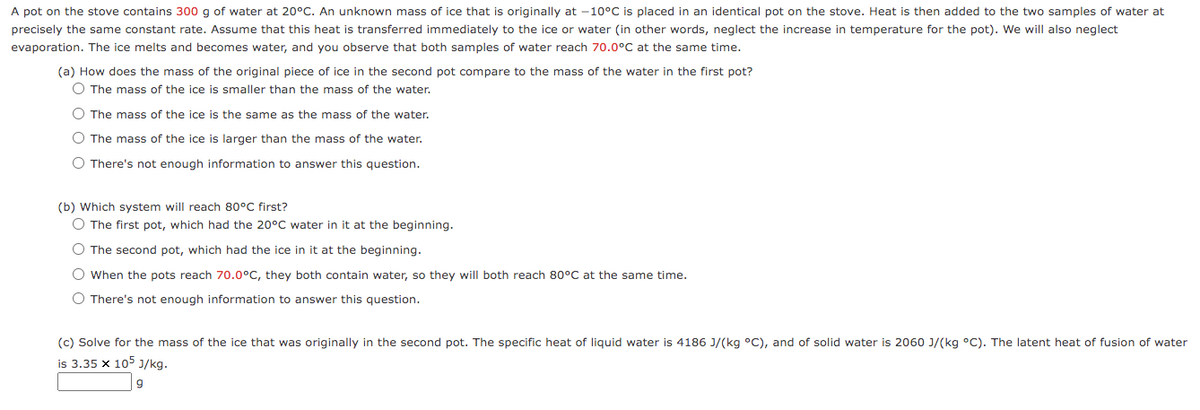A pot on the stove contains 300 g of water at 20°C. An unknown mass of ice that is originally at -10°C is placed in an identical pot on the stove. Heat is then added to the two samples of water at precisely the same constant rate. Assume that this heat is transferred immediately to the ice or water (in other words, neglect the increase in temperature for the pot). We will also neglect evaporation. The ice melts and becomes water, and you observe that both samples of water reach 70.0°C at the same time. (a) How does the mass of the original piece of ice in the second pot compare to the mass of the water in the first pot? O The mass of the ice is smaller than the mass of the water. O The mass of the ice is the same as the mass of the water. O The mass of the ice is larger than the mass of the water. O There's not enough information to answer this question. (b) Which system will reach 80°C first? O The first pot, which had the 20°C water in it at the beginning. O The second pot, which had the ice in it at the beginning. O When the pots reach 70.0°C, they both contain water, so they will both reach 80°C at the same time. O There's not enough information to answer this question. (c) Solve for the mass of the ice that was originally in the second pot. The specific heat of liquid water is 4186 J/(kg °C), and of solid water is 2060 J/(kg °C). The latent heat of fusion of water is 3.35 x 105 J/kg.
Energy transfer
The flow of energy from one region to another region is referred to as energy transfer. Since energy is quantitative; it must be transferred to a body or a material to work or to heat the system.
Molar Specific Heat
Heat capacity is the amount of heat energy absorbed or released by a chemical substance per the change in temperature of that substance. The change in heat is also called enthalpy. The SI unit of heat capacity is Joules per Kelvin, which is (J K-1)
Thermal Properties of Matter
Thermal energy is described as one of the form of heat energy which flows from one body of higher temperature to the other with the lower temperature when these two bodies are placed in contact to each other. Heat is described as the form of energy which is transferred between the two systems or in between the systems and their surrounding by the virtue of difference in temperature. Calorimetry is that branch of science which helps in measuring the changes which are taking place in the heat energy of a given body.

Trending now
This is a popular solution!
Step by step
Solved in 4 steps






